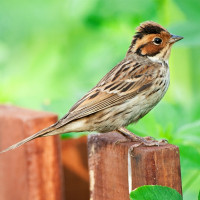Opis
Fanø (Fanoe) is the northernmost of the three inhabited Danish islands in the Wadden Sea. Fanø is a flat island made of sand with dunes and saltmarshes around on the eastern side. The island has a high diversity of nature with many seals, birds and deers. Many different kinds of scenery are represented here: sandy beaches, dunes, coastal meadows, heath and plantations. Around Sønderho on the island’s southernmost point are the three sandflats Keld Sand, Peter Meyers Sand and Langejord, where tens of thousands of waders roost at high tide. The migration is monitored by Fanø Birdstation by migration observations and ringing. Millions of waterbirds are resting, more than 750.000 passerines and raptors are migrating from the south-tip called "Hønen".
Breeding birds include sieweczka morska, rybitwa białoczelna, lelek and błotniak stawowy. For certain migrating species Fanoe is among the best places in northern Europe to watch them. For example pliszka górska, drozd obrożny, trznadelek, błotniak stepowy and finches.
Szczegóły
Dostęp
You can only go by boat from Esbjerg to Fanø. The crossing takes 10-15 minutes. It is possible to bring a bicycle or a car. The island is 15 km long and 3 km wide. Most of the island is accessible apart from the sand flats in the south east, Keld Sand and Trinden, where access is prohibited. Motor transport is forbidden on many roads through the woods and minor roads. The busiest roads have cycle lanes and there are bicycles for hire in Nordby, Rindby and Sønderho. B&B is possible by calling +45 20108717. Guided tours by www.nationalparksafari.dk.
Teren i siedlisko
Tereny podmokłe , Łąka , Wrzosowisko , Wydmy , Błota , Plaża , Miasto/wieś , Rolnictwo/uprawy , LasWarunki
Płaski , Piaszczysty , Otwarty krajobraz , Możliwy wysoki poziom wodyTrasa dookoła
TakCzy luneta będzie przydatna ?
TakUdany sezon obserwacyjny
Przez cały rokNajlepszy czas na wizytę
Jesienne migracje , Wiosna , LatoTrasa
Droga utwardzona , Droga nieutwardzona , Wąski szlakPoziom trudności szlaku pieszego
ŁatwyDostępne
Pieszo , Rower , Samochód , Wózek inwalidzkiCzatownia/platforma obserwacyjna
TakDodatkowe informacje
Next to the bay of Albuebugten is the Sønderho Old Duck Decoy, which is always open. Here there is a bird observation tower with a view over the Wadden Sea.

.jpg)


